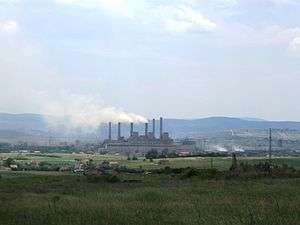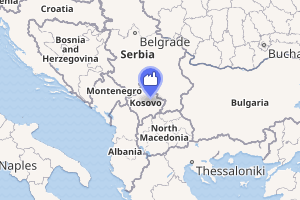Kosovo A Power Station
Kosovo A Power Station is a lignite power station with five units at Obilić, Kosovo.[lower-alpha 1] It is the second largest power station in Kosovo with capacity of 650 MW after Kosovo B Power Station. It is described as the worst single-point source of pollution in Europe and it is expected to be closed by 2017.[1]
| Kosovo A Power Station | |
|---|---|
 | |

| |
| Country | Kosovo[lower-alpha 1] |
| Location | Obilić |
| Coordinates | 42°40′31″N 21°5′0″E |
| Status | Operational |
| Construction began | 1962 |
| Decommission date | 2017 (expected) |
| Owner(s) | Korp Elektroenergjetike e Kosoves |
| Thermal power station | |
| Primary fuel | Lignite |
| Power generation | |
| Nameplate capacity | 800 MW |
| External links | |
| Commons | Related media on Commons |
History
Kosovo A Power Station was opened in 1962. It was operated by EPS Surface Mining Kosovo and EPS TPP Kosovo until the end of Kosovo War. After UNMIK administration was established in Kosovo on 1 July 1999, Elektroprivreda Srbije (EPS) lost its access to the local coal mines and power plants, including Kosovo A and Kosovo B power plants.[2]
Since then, it is operated by Korporata Energjetike e Kosovës (KEK).
In December 2015, US-based company ContourGlobal signed a memorandum of understanding with the Government of Kosovo, to build a new $1.06 billion worth power plant to replace 45-year old Kosovo A Power Station.[3] The construction is expected to start in 2018.[3]
Generation units
- Unit 1 has a generation power of 50 MW and a 120 metres (390 ft) tall chimney with a diameter of 4 metres (13 ft) at the top.
- Unit 2 has a generation power of 200 MW and a 120 metres (390 ft) tall chimney with a diameter of 7 metres (23 ft) at the top.
- Unit 3 has a generation power of 250 MW and a 120 metres (390 ft) tall chimney with a diameter of 7 metres (23 ft) at the top.
- Unit 4 has a generation power of 350 MW and a 150 metres (490 ft) tall chimney with a diameter of 7 metres (23 ft) at the top.
Events
2014
On 6 June 2014, the power station exploded killing two people and injuring 13 others. The station was then subsequently shut down. The cause of the explosion was due to the explosion of hydrogen tank located in a separate part of the power station from the generator.[4][5]
Notes
- Kosovo is the subject of a territorial dispute between the Republic of Kosovo and the Republic of Serbia. The Republic of Kosovo unilaterally declared independence on 17 February 2008, but Serbia continues to claim it as part of its own sovereign territory. The two governments began to normalise relations in 2013, as part of the 2013 Brussels Agreement. Kosovo is currently recognized as an independent state by 97 out of the 193 United Nations member states. In total, 112 UN member states recognized Kosovo at some point, of which 15 later withdrew their recognition.
References
-
"World Bank Group Support to Kosovo's Energy Sector" (PDF). World Bank. 10 February 2012. Retrieved 2013-03-17. Cite journal requires
|journal=(help) - "About Us". eps.rs. Archived from the original on 12 August 2014. Retrieved 14 January 2018.
- "US ContourGlobal to launch tendering for Kosovo power plant construction in April". seenews.com. Retrieved 15 January 2018.
- "Explosion at Kosovo power plant - RTÉ News". Rte.ie. Retrieved 2014-06-09.
- "BBC News - Two killed in Kosovo power station blast near Pristina". Bbc.co.uk. 1970-01-01. Retrieved 2014-06-09.